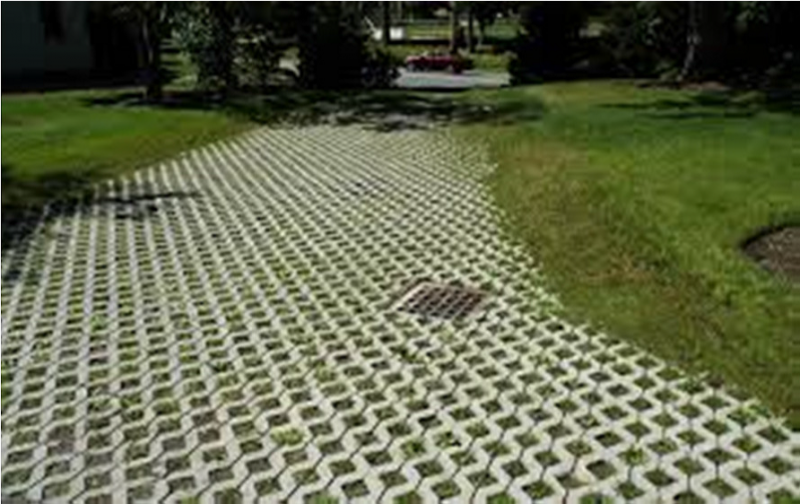Permeable paving is designed to allow rainwater to infiltrate through the surface, either into underlying layers (soils and aquifers), or be stored below ground and released at a controlled rate to surface water. Permeable paving is used as a general term, but two types can be distinguished:
- Porous pavements, where water is infiltrated across the entire surface (e.g. reinforced grass or gravel, or porous concrete and cobblestones)
- Permeable pavements, where materials such as bricks are laid to provide void space through to the sub-base, by use of expanded or porous seals (rather than mortar or other fine particles).
It is most commonly used on roads and car parks, but the measure can also apply to broader use of permeable areas to promote greater infiltration. It can be used in most ground conditions and can be sited on waste, uncontrolled or non-engineered fill, providing the degree of compaction of the foundation material is high enough to prevent significant differential settlement. A liner may be required where infiltration is not appropriate, or where soil integrity would be compromised.
CIRIA (2007) and the “Centre des recherches routières” (Road Research Centre) of Brussels (2008) describes three different types of porous/permeable pavements:
- All rainfall passes through sub-structure and in to soils beneath, with (normally) no surface discharge (i.e. fully infiltrating);
- Perforated pipes lie between the sub-base and underlying sub-soil, to convey rainfall that exceeds the capacity of the sub-soil to a receiving drainage system (i.e. partially infiltrating);
- Perforated pipes lie beneath the sub-base, over an impermeable membrane, so all rainfall, after filtering through the sub-base, is conveyed to the receiving drainage system (i.e. no infiltration).
All types provide attenuation of rainfall, and potentially can also store runoff from surrounding areas, if designed and sized appropriately. Types A and B provide infiltration to underlying groundwater, thereby contributing to increased groundwater levels and/or flows, and hence potentially to baseflow. Type C does not interact with groundwater, but stores rainfall (and potentially runoff) and releases it at a controlled rate, hence still contributes to regulating the rate of rainfall-runoff.

Permeable paving
Source: Andras Kis’ presentation, NWRM Workshop 1
| Benefits | Level |
|---|---|
|
ES1 - Water storage
|
Medium
|
|
ES5 - Climate change adaptation and mitigation
|
Low
|
|
ES6 - Groundwater/aquifer recharge
|
Medium
|
|
ES7 - Flood risk reduction
|
Medium
|
|
ES8 - Erosion/sediment control
|
Low
|
|
ES9 - Filtration of pollutants
|
Low
|
|
PO2 - Improving status of physico-chemical quality elements
|
Low
|
|
PO4 - Improving chemical status and priority substances
|
Low
|
|
PO5 - Improving quantitative status
|
Low
|
|
PO7 - Prevent surface water status deterioration
|
Low
|
|
PO9 - Take adequate and co-ordinated measures to reduce flood risks
|
High
|
|
PO11 - Better protection for ecosystems and more use of Green Infrastructure
|
Low
|
|
BP1 - Store runoff
|
Medium
|
|
BP2 - Slow runoff
|
Medium
|
|
BP6 - Increase infiltration and/or groundwater recharge
|
Medium
|
|
BP8 - Reduce pollutant sources
|
Low
|
|
BP9 - Intercept pollution pathways
|
Low
|